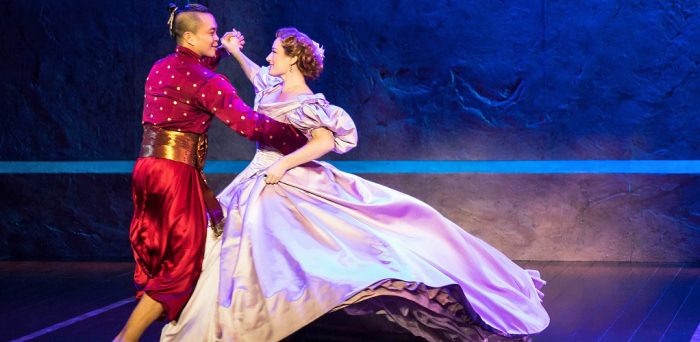
The King and I by Richard Rodgers & Oscar Hammerstein II. Bartlett Sher directed. On tour, 2017.
The King and I continues to offer new interpretations, 66 years after it was created by Rodgers & Hammerstein. This play is a wonder of American musical theater.
Jose Llana offers a new vision of the king in the national tour of Bartlett Sher’s production that was first seen at Lincoln Center in 2015. He is less fierce than Yul Brynner and almost every king since then; intelligent, less primitive, more educated, more charming (and youthful, too.) This squares with the fact that this king is an avid reader, and has reached out to hire a British teacher for his children as he obviously wants his people to learn Western customs. This adds shock value to the Act II scene where he suddenly becomes barbaric upon discovering that his newest wife has run off with another man.
The show takes us back to 1862 when the widowed British schoolteacher Anna Leonowens arrives in Siam to instruct the royal children. She begins a complicated connection with that small nation’s imperious monarch. Anna and her son Louis are bewildered by the alien culture, yet she finds herself drawn towards the king. There is a mutual attraction which neither of them is able to admit.
Llana adds a welcome bit of humor with his clumsiness when he starts learning how to polka in “Shall We Dance?” He is a much better vocalist than most men who’ve done the role; Llana, after all, was the young lover Lun Tha (who sings “I Have Dreamed” and “We Kiss in the Shadows”) in the 1993 Broadway revival. Still and all, there’s some loss of conflict and of tension when the king presents himself as a less frightening figure.
In addition to those dance moves, several comic lines are given more emphasis this time. Is it a form of catering to the supposedly less-sophisticated audiences that the producers expect to find on the road? It’s a notable fact that The King and I was written without any of the comic-relief scenes of the earlier Rodgers & Hammerstein shows Oklahoma! (the Ado Annie scenes), Carousel (Jigger carrying Carrie into the woods), and South Pacific (Luther Billis’s antics).
Laura Michelle Kelly was fine as Anna, in a conventional interpretation that could stand a bit more grit and spunk. Her singing voice is excellent, especially on high notes. The supporting roles of Lady Thiang, the slave girl Tuptim, and Lun Tha were outstandingly cast with Joan Almedilla, Manna Nichols, and Kavin Panmeechao. Anthony Chan was a rather mature-looking crown prince who strongly projected himself, and Graham Montgomery was an adorable Louis Leonowens.
Almedilla was magnificent in her rendition of Oscar Hammerstein’s quintessential anthem of a woman adoring her man even when he’s imperfect, “Something Wonderful.” (Hammerstein also expressed that sentiment in “Can’t Help Lovin’ That Man” and “What’s the Use of Wondering?” in Show Boat and Carousel.)
All of the cast sing the great Richard Rodgers melodies with superbly long, coherent phrasing that was taught by the production’s original musical director, Ted Sperling.
Sher directed with discerning interaction among characters and he added excellent detail to the movements of the royal children. The high point of the production is, as it always was, the ballet “The Small House of Uncle Thomas” in which Tuptim stages a declaration that the king of Siam is as much a tyrant as was Simon Legree in “Uncle Tom’s Cabin.” This scene sums up the conflict between the cultures, and between the king’s aspirations and his limitations.
We’ve seen fine Jerome Robbins ballets presented by dance companies, plus revivals of his West Side Story and Fiddler on the Roof, yet this ballet is the most beautiful and creative of everything that he achieved. The solo dancers were superb, especially LaMae Caparas as Eliza.
When a Broadway show goes on the road, we expect fewer performers. Indeed, in New York this production had a cast of 50 and now there are 37; at Lincoln Center the king had 13 wives and now there are 10, and instead of 18 dancers we now have 12. More economy was apparent in the physical staging. Most scenes were played on a shallow stage with a wall as background. This was a major disappointment because when Sher’s previous Lincoln Center musical, South Pacific, went on tour it retained a good deal of stage depth and third-dimensional movement. The King and I did not transfer as faithfully.
The costumes by Catherine Zuber were gorgeous, while the orchestra under Gerald Steichen sounded understaffed at 16. Touring productions such as this are essential, and theater-lovers around the country will get great value when they attend, but the truth is that no theater can match the consistently outstanding results that are produced at Lincoln Center, especially on the huge thrust stage of its Vivian Beaumont Theatre.
For a reminder of the Lincoln Center production, click here.
For a glimpse at Uncle Tom’s Cabin, click here.